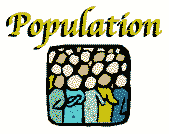|
|
|
|
|
|
|

| Thailand's population is relatively homogeneous. More than 85% speak a dialect of Thai and share a common culture. This core population includes the central Thai (36% of the population), Thai-Lao (32%), northern Thai (8%), and southern Thai (8%). The language of the central Thai population is the language taught in schools and used in government. Several other small Thai-speaking groups include the Shan, Lue, and Phutai. The largest minorities are the Chinese (about 12% of the population) and the Malay-speaking Muslims of the south (3%). Other groups include the Khmer, the Mon (who are substantially assimilated with the Thai), and the Vietnamese. Smaller, predominantly mountain-dwelling tribes, such as the Hmong, Karen, and Mein, number about 500,000. |
| POPULATION GRAPH |
 |
|
Population:
65,998,436 country comparison to the world: 20 note: estimates for this country explicitly take into account the effects of excess mortality due to AIDS; this can result in lower life expectancy, higher infant mortality, higher death rates, lower population growth rates, and changes in the distribution of population by age and sex than would otherwise be expected (July 2009 est.) Age structure: 0-14 years: 20.8% (male 7,013,877/female 6,690,554) 15-64 years: 70.5% (male 23,000,156/female 23,519,298) 65 years and over: 8.7% (male 2,612,269/female 3,162,282) (2009 est.) Median age: total: 33.3 years male: 32.4 years female: 34.2 years (2009 est.) Population growth rate: 0.626% (2009 est.) country comparison to the world: 150 Birth rate: 13.38 births/1,000 population (2009 est.) country comparison to the world: 156 Death rate: 7.12 deaths/1,000 population (July 2009 est.) country comparison to the world: 128 Net migration rate: NA (2009 est.) Urbanization: urban population: 33% of total population (2008) rate of urbanization: 1.7% annual rate of change (2005-10 est.) Sex ratio: at birth: 1.05 male(s)/female under 15 years: 1.05 male(s)/female 15-64 years: 0.98 male(s)/female 65 years and over: 0.83 male(s)/female total population: 0.98 male(s)/female (2009 est.) Infant mortality rate: total: 17.48 deaths/1,000 live births country comparison to the world: 114 male: 18.48 deaths/1,000 live births female: 16.43 deaths/1,000 live births (2009 est.) Life expectancy at birth: total population: 73.1 years country comparison to the world: 113 male: 70.77 years female: 75.55 years (2009 est.) Total fertility rate: 1.65 children born/woman (2009 est.) country comparison to the world: 179 HIV/AIDS - adult prevalence rate: 1.4% (2007 est.) country comparison to the world: 46 HIV/AIDS - people living with HIV/AIDS: 610,000 (2007 est.) country comparison to the world: 18 HIV/AIDS - deaths: 30,000 (2007 est.) country comparison to the world: 17 Major infectious diseases: degree of risk: high food or waterborne diseases: bacterial diarrhea vectorborne diseases: dengue fever, Japanese encephalitis, and malaria animal contact disease: rabies water contact disease: leptospirosis note: highly pathogenic H5N1 avian influenza has been identified in this country; it poses a negligible risk with extremely rare cases possible among US citizens who have close contact with birds (2009) Nationality: noun: Thai (singular and plural) adjective: Thai Ethnic groups: Thai 75%, Chinese 14%, other 11% Religions: Buddhist 94.6%, Muslim 4.6%, Christian 0.7%, other 0.1% (2000 census) Languages: Thai, English (secondary language of the elite), ethnic and regional dialects Literacy: definition: age 15 and over can read and write total population: 92.6% male: 94.9% female: 90.5% (2000 census) School life expectancy (primary to tertiary education): total: 14 years male: 13 years female: 14 years (2006) Education expenditures: 4.2% of GDP (2005) country comparison to the world: 99 |


